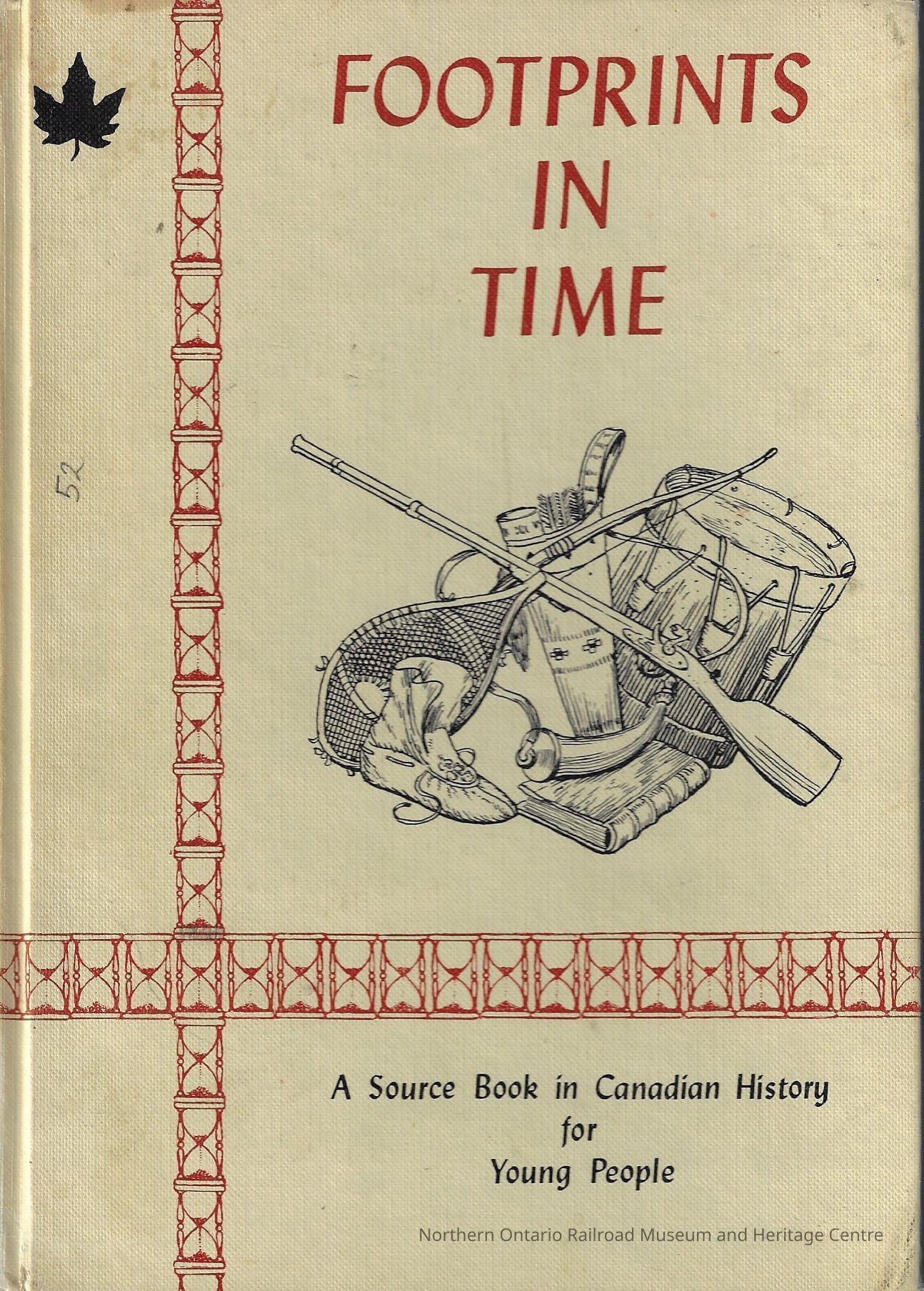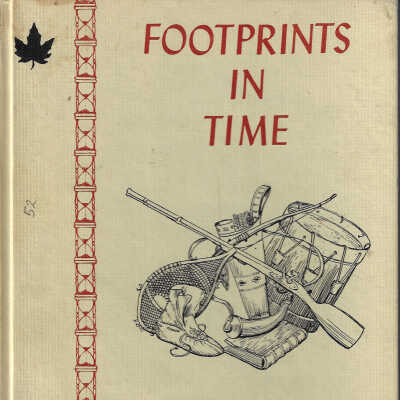Footprints in Time: a Source Book in Canadian History for Young People
Name/Title
Footprints in Time: a Source Book in Canadian History for Young PeopleEntry/Object ID
2022.74.01Tags
Canadian History, Indigenous History, Colonialism, War History, Railway History, Fur Trade, Mining History, Lumber HistoryScope and Content
Book describing the history of Canada covering between the 1630s and the 1930s.Context
The book presents primary sources as well as historical context surrounding the sources to describe the history of Canada. The book is broken down into chapters, each exploring different aspects of Canadian history. They are as follows: 1. The Discovery: -Before the Coming of the White Man: The Jesuit, Father du Peron describes the Huron Country, 1639. Father Brebeuf, another Jesuit, tells about the Huron Indians, 1635 - Norse Discovery: Norse saga about Karlsefni's visit to North America - England's First Claim: Part of Henry VII's "letters patent" to the explorer, John Cabot. - Cartier Explores the St. Lawrence 1535: Jacques Cartier's own description of Hochelga 2. The Birth of New France: - Champlain Founds Quebec, July 1608: Champlain's own account of how he built Canada's first settlement - Champlain Fights the Iroquois, 1609: Champlain describes his first battle with the Iroquois - First Settler in the Colony: Land deed issued in 1626 to Louis Herbert - An Early Coureur De Bois: Description of Jean Nicolet, written about 1642. - The Black Robes: Father Le Jeune tells his fellow Jesuits what hardships to expect in New France 3. New France Flourishes: - The Great Intendant: Letters between Jean Talon and Louis XVI's chief minister Colbert describing enterprises in the colony 1667-1671 - King Louis Encourages Large Families: Royal proclamation of 1670 offering "baby bonuses" - Bishop Laval Fosters Education: The First Bishop of New France tells of establishing a school in 1668 - Frontenac Deals with the Iroquois: An eyewitness account of Frontenac's conference with the Iroquois at Cataraqui 1673 - Life on the Seigneury: An Intendant describes the people of New France. A French visitor explains how maple sugar is secured. - A French-Canadian Folk Song: Words and melody of "En Roulant Ma Boule" - La Salle Reaches the Gulf of Mexico: One of La Salle's companions describes that dramatic day, April 9, 1682 when La Salle reached the Gulf of Mexico - La Verendryes Push Westward: Part of a report by one of the La Verendryes in respect to the journey of 1742, 1743 which may have taken him to the foothill of the Rockies 4. England Plants Colonies: - The Pilgrims in New England, 1620: Part of the "Mayflower Compact" 1620. William Bradford's log records the start of the settlement - Puritan Life in Early Massachusetts: Examples of early justice in Massachusetts Bay. The Twelve God Rules: a set of Puritan rules of behaviour. - Radisson Serves the English: Part of Pierre Radisson's account of how he and Groseilliers were received in England in 1665 -The English Establish Rupert's Land: Part of the charter of the Hudson's Bay Company issued May 2, 1670. - First on the Prairies: Henry Kelsey's account (written in poetry) of his 1690-1691 season on the plains. Kelsey describes the life of the Plains Indians. 5. The Struggle for a Continent: - A Boarder Settlement is Raided: Reverend John Williams describes the Deerfield massacre, 1704. - The Founding of Halifax: Governor Cornwallis describes the location. A settler's description of the progress made in construction. - The Expulsion of the Acadians: Governor Lawrence's instructions to Colonel Winslow, 1755. Colonel Winslow tells how he carried out the orders. - The Plains of Abraham: Captain John Knox's account of the defeat of the Montcalm. - Ruling the Conquered: Governor Murray's report of 1762 describes the good relationship between the British and French Canadians. Message from citizens to Governor of Montreal - Alexander Henry Escapes Death at Michilimackinac: Henry's account of how he escaped the massacre planned by Pontiac - The Quebec Act: Significant clauses from the Quebec Act, 1774. - The Quebec Act and the Canadians: Reaction of a Quebec resident to the Quebec Act. An excerpt from one of Governor Carleton's reports. Discontent of some of the French inhabitants as outlined in a letter of the 1775 by an American at the beginning of the Revolution. 6. Americans and Canadians: -The Revolutionists Invade Canada: American commanders tell how the actions of their soldiers have forfeited the support of the French Canadians. The American General Thomas explains why he had to retreat from Quebec - A Loyalist Describes the New Homestead: A Loyalist recalls the hardships of settlement in the Niagara District - The Constitutional Act, 1791: Significant clause from the Act creating two colonies - Governor Simcoe Plans a Fort and Town: In a letter of 1793, Simcoe describes his plans for the site of York. - An American Fleet Enters Toronto Harbour: Rev. John Strachan describes the entry of an American invasion fleet, 1813. - Citizens Comment on the War: Thomas G. Ridout describes his service in the militia during the War of 1812. An American judge views the war with misgivings. 7. Pioneers Build Communities: - The Peter Robinson Settlement: Part of Robinson's report of May 1827 to Lord Goderich describing the location of immigrants. A settler's description of the first homes. - Surveying Future Communities: Part of a letter of 1823 describing a surveying party. A surveyor, Thomas Smith, reports on the difficulties of surveying, 1820. -Neighbourhood Bees: A description of barn raising. A description of a mowing and cradling bee. - Pioneer Parties: Sir George Head describes a party given in his honour, 1815. A picture of a night's fun in the village of Perth. - Early Industries: A description of how the erection of a mill led to other developments - The Three R's: In a letter of 1841, a teacher tells of his employment. A visit to a school at Thornhill, 1829. A settler recalls his school days. - A Journey by Stage Coach: A journey by stage coach in 1831. - An Early Lumber Camp: A description of a typically dangerous operation. 8. Opening Up the West: - Nor'Westers at Grand Portage: Alexander Mackenzie describes a meeting of fur traders. - Captain Cook Trades with the Nootka Indians: Part of Cook's account of 1778 of how he traded with the West Coast Indians. - Alexander Mackenzie Reaches the Pacific: Mackenzie tells of that day, July 22, 1793 when he reached the Pacific. - Simon Fraser Explores His River: Fraser's description of 1808 of the almost impossible passages through one of the Fraser River's gorges. - The Massacre at Seven Oaks: One of the Selkirk settlers describes the battle with the Metis on June 19, 1816. - The Rush to the Cariboo: A young Englishman's description of Victoria as a booming mining centre. 9. Rebellion: - Mackenzie Rouses the People: A rousing appeal in the "Colonial Advocate," January 12, 1832. A denunciation of the Family Compact from "The Constitution", July 12, 1837. Handbill published by Mackenzie in 1837. - Robert Baldwin Pleads His Cause in England: Baldwin's plea for Responsible Government, 1836. - The Battle of Gallow's Hill or Montgomery's Farm: A member of the government forces describes the defeat of the rebels, December 7, 1837. - An Early Election: A description of an open election in Lanark County, 1820. - Lord Durham's Report: Significant excerpts from Durham's Report, 1838. 10. A Nation is Born: - A Fugitive Slave is Caught: The description of the capture of a runaway slave at Niagara Falls at about 1850. - War at our Doorstep: A bitter journalistic attack on Canada by the "New York Herald" in 1861 at the time of the American Civil War. The "New York Herald" tells of Canadian based Confederate raids. In a letter of 1865, John A. Macdonald voices Canadian anxiety about the great, empty Northwest. - John A. Macdonald Calls for Nationalism: In 1865, Macdonald urges the Parliament of Canada to back Confederation. - The British North America Act: Some of the main causes from the Act passed by the British Parliament. 11. The Expanding Dominion: - Palliser Explores the Rockies: In a portion of his journal of 1859, Captain John Palliser records his exploration of a mountain pass. - Indians and Metis Become Uneasy: A petition of 1871 from a Cree Chief to the Lieutenant-Governor of the Northwest Territories. Inspector Denny of the North West Mounted Police describes a Metis hunting party, 1874. - North West Mounted Police Fight the Liquor Traders: Inspector Denny's story of an arrest of a "whiskey trader". - The Indians Surrender Their Lands: Part of the treaty made with the Blackfoot and other tribes. - The Trials of Early Homesteaders: A pioneer recalls the experiences of a group of new settlers. - The Railway Goes Through the Rockies: An engineer describes some of the problems. - The Battle of Fish Creek: Gabriel Dumont, Riel's second in command, describes his part in the battle of the Northwest Rebellion. - Manitoba Upholds its Public School Law: An M. P. defends the federal government's action in trying to alter the Manitoba Public School Law in a speech of March 31, 1869. The Secretary-Treasurer of the Winnipeg School Board reflects the feelings in the Manitoba Capital. Wilfred Laurier outlines his stand. - Gold Fever in the Yukon: A prospector describes his arrival in Dawson on July 27, 1898. - A Canadian Army Serves Abroad: Prime Minister Sir Wilfred Laurier comments on Canada's contribution to the British forces in the Boer War. - Two New Provinces - Alberta and Saskatchewan: The "Globe" of Toronto describes the celebrations when Alberta became a province on September 1, 1905. - The Statute of Westminister, 1931: Important extracts from the Statute.Collection
Canadian History Collection (General)Cataloged By
unknownCategory
Secondary Source

